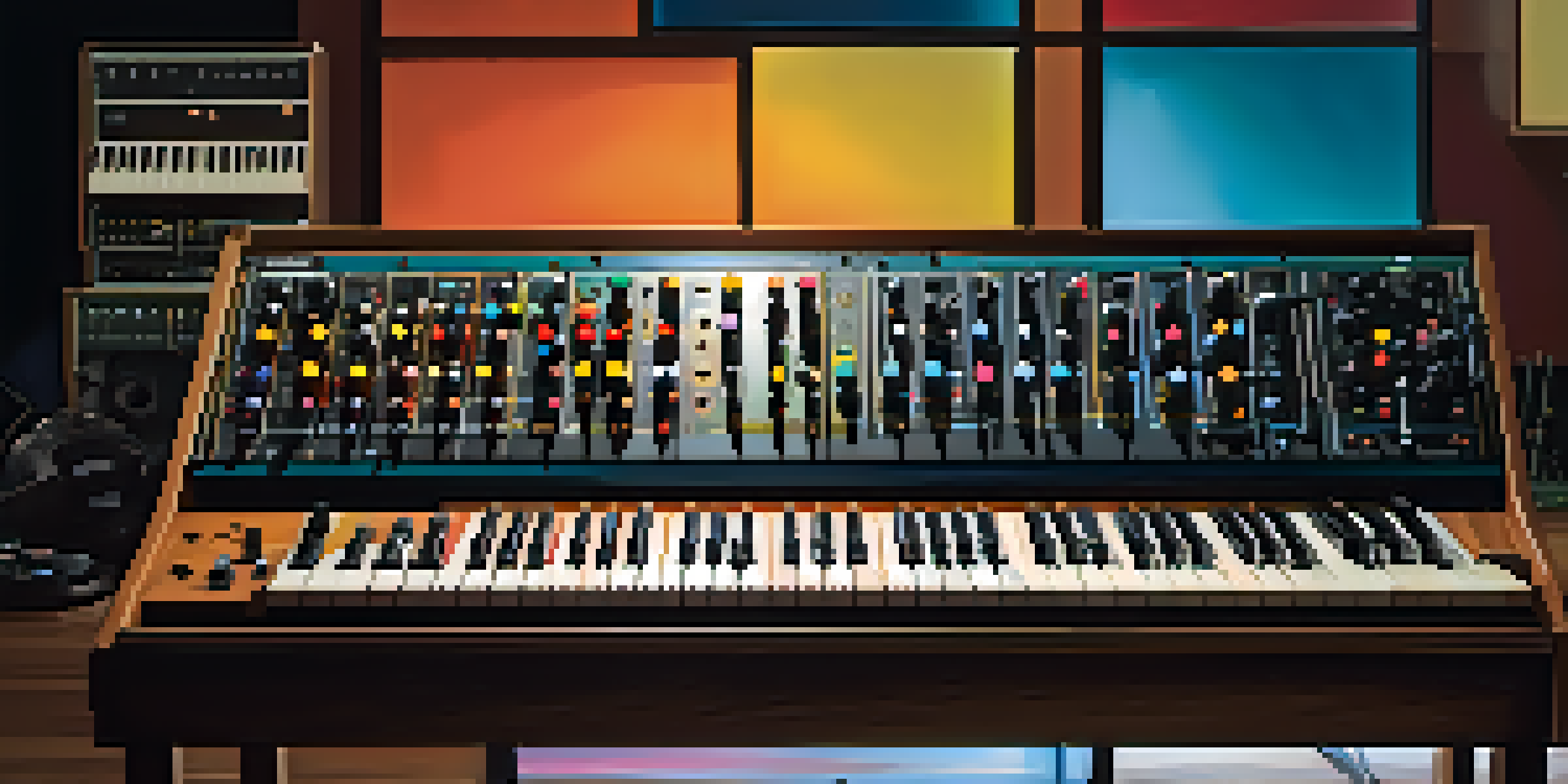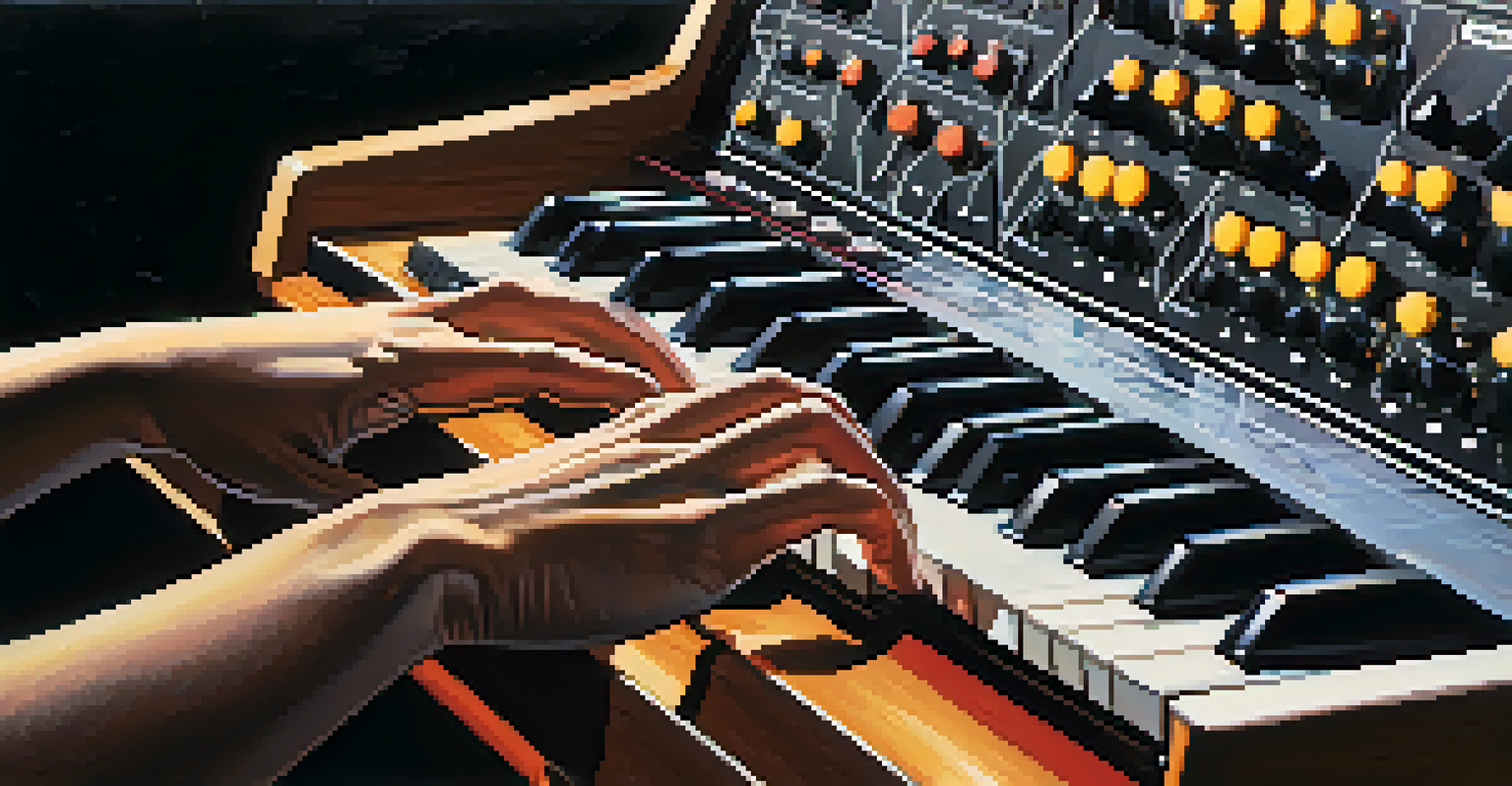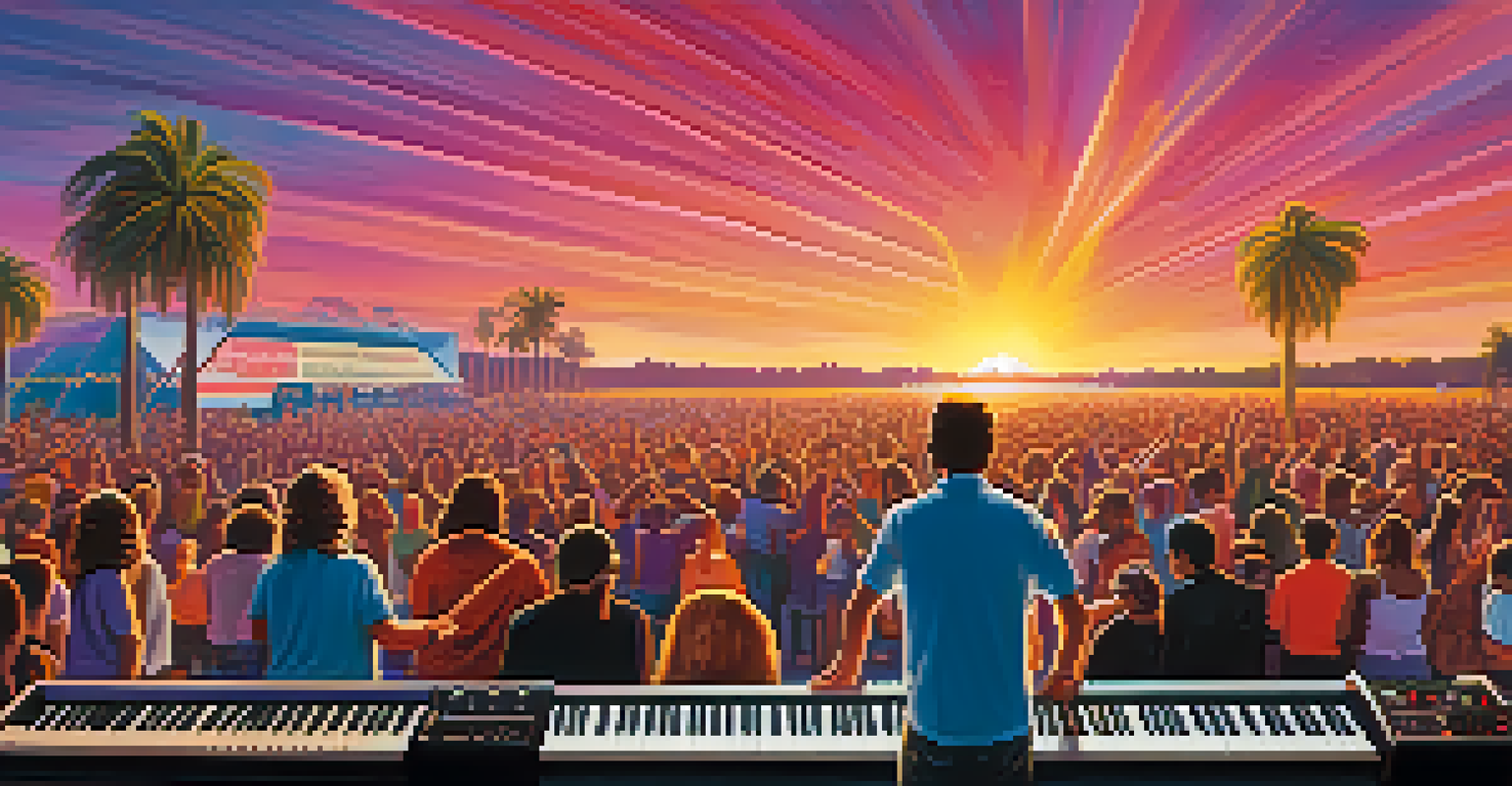The Moog Synthesizer: Revolutionizing Modern Music

The Birth of the Moog Synthesizer and Its Impact
In the early 1960s, Robert Moog introduced the world to the Moog synthesizer, a groundbreaking instrument that would change music forever. It combined electricity and sound in a way that allowed musicians to explore new sonic landscapes. This innovation marked the beginning of synthesizers as essential tools in various music genres, from rock to electronic.
The synthesizer is a tool for creative growth, and it’s a world of possibility that is never-ending.
The Moog synthesizer enabled artists to create sounds that were previously unimaginable. Its unique design, featuring knobs and sliders, made it not just an instrument but also a canvas for creativity. Musicians could manipulate sound waves and create textures that added depth and emotion to their music.
As the Moog synthesizer gained popularity, it found its way into recording studios and live performances, influencing countless artists. Legendary bands like The Beatles and Pink Floyd incorporated its rich tones into their music, showcasing its versatility. This shift in sound helped pave the way for the electronic music revolution.
Understanding the Technology Behind the Moog
At its core, the Moog synthesizer operates using oscillators, filters, and envelopes. Oscillators produce sound waves, which can be shaped and transformed through filters to create various tones. Envelopes control the dynamics of these sounds, allowing musicians to create everything from smooth pads to sharp staccato notes.

One of the defining features of the Moog synthesizer is its analog circuitry. Unlike digital synthesizers, which use computer algorithms to generate sound, analog synthesizers create sound using voltage-controlled components. This gives the Moog its warm, rich tones that many musicians and producers still prefer today.
Moog Synthesizer Revolutionized Music
The introduction of the Moog synthesizer in the 1960s transformed music by allowing artists to explore new sonic possibilities across various genres.
Understanding this technology opens up a world of possibilities for musicians. By learning how to manipulate the parameters of the synthesizer, artists can create unique sounds tailored to their vision. This flexibility is one of the reasons why the Moog remains a beloved instrument among musicians.
The Moog in Different Music Genres
The versatility of the Moog synthesizer makes it suitable for a wide range of music genres. From the psychedelic rock of the 1960s to the dance beats of modern electronic music, its influence is evident. Artists like Wendy Carlos and Kraftwerk helped popularize the Moog in mainstream music, showcasing its potential across various styles.
I think that the synthesizer is an instrument that can do anything, and it is an instrument that is still being explored.
In hip-hop, the Moog has been embraced for its ability to produce deep bass lines and catchy melodies. Producers have utilized its rich sound to create iconic tracks that define the genre. This adaptability ensures the Moog's continued relevance in an ever-evolving musical landscape.
Moreover, the synthesizer has made a significant impact on film scores. Composers like John Carpenter used the Moog to create atmospheric soundscapes that enhance the emotional depth of their films. Its ability to evoke feelings through sound has made it a staple in cinematic music production.
Iconic Moog Tracks That Shaped Music History
Several tracks have become synonymous with the Moog synthesizer, showcasing its transformative power. One standout example is 'Switched-On Bach' by Wendy Carlos, which brought classical music to the forefront of electronic sound. This groundbreaking album introduced many listeners to the possibilities of synthesized music.
Another iconic track is 'On The Run' by Pink Floyd from their album 'The Dark Side of the Moon.' The song features haunting Moog sounds that perfectly complement the album's themes of time and existentialism. Such tracks illustrate how the Moog synthesizer can elevate a musical piece to new heights.
Moog's Versatility Across Genres
The Moog synthesizer's rich sound and adaptability have made it a staple in diverse music styles, from rock to hip-hop and film scores.
These tracks not only highlight the Moog's capabilities but also its lasting legacy in music history. They serve as reminders of how this innovative instrument has inspired generations of musicians to push the boundaries of sound.
The Moog Synthesizer's Influence on Modern Artists
Today, many contemporary artists continue to draw inspiration from the Moog synthesizer. Musicians like Daft Punk and Radiohead incorporate its classic sounds into their work, blending old and new techniques. This connection to the past helps establish a rich musical dialogue across generations.
Moreover, the resurgence of analog synthesizers in recent years has sparked a renewed interest in the Moog. With the rise of genres like synthwave and retro-pop, many artists are exploring vintage sounds to create modern hits. This trend demonstrates how the Moog remains a relevant and influential instrument in today's music scene.
Additionally, the accessibility of Moog products, including compact versions and software emulations, allows a new generation of musicians to experiment with its sounds. This democratization of music production helps ensure that the Moog continues to inspire creativity and innovation in the years to come.
Learning to Play the Moog Synthesizer
For those interested in exploring the Moog synthesizer, there are many resources available to help you get started. Online tutorials, community forums, and dedicated classes can provide invaluable insights into mastering this complex instrument. With a bit of patience and practice, anyone can unlock the potential of the Moog.
One of the best ways to learn is through experimentation. Don't be afraid to twist knobs, slide faders, and explore different sound combinations. This hands-on approach can lead to unexpected discoveries and a deeper understanding of how the synthesizer works.
Future of Moog Remains Bright
With ongoing innovations and a resurgence in analog sounds, the Moog synthesizer continues to inspire modern musicians and shape the future of music.
Additionally, collaborating with other musicians can enhance your learning experience. Sharing ideas and techniques can spark creativity and provide new perspectives on sound design. The Moog synthesizer is not just an instrument; it's a tool for collaboration and artistic expression.
The Future of the Moog Synthesizer
As technology continues to evolve, the Moog synthesizer remains at the forefront of music innovation. The company consistently releases new models and updates that incorporate modern features while retaining the classic sound that fans love. This commitment to quality ensures that the Moog will remain a vital part of the music landscape.
Moreover, advancements in digital technology have allowed Moog to create software versions of their iconic sounds. These virtual synthesizers provide accessibility for musicians who may not have the means to invest in physical instruments. This blend of traditional and modern techniques keeps the Moog relevant in an ever-changing industry.

Looking ahead, the future of the Moog synthesizer seems bright. As more musicians and producers embrace its unique capabilities, we can expect to see new genres and sounds emerging. The Moog will undoubtedly continue to inspire creativity, shaping the future of music for years to come.